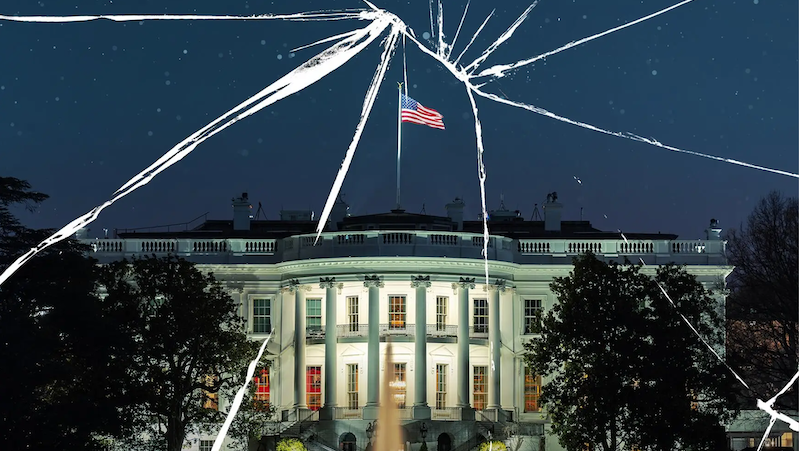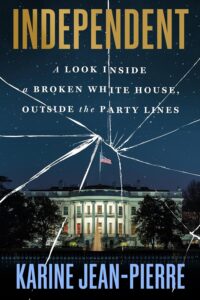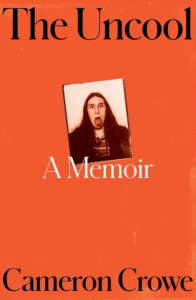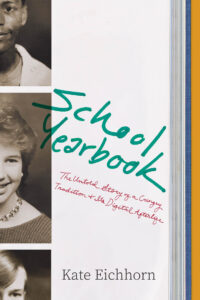
Our mixum-gatherum of marvelous reviews this week includes Becca Rothfeld on Karine Jean-Pierre’s Independent, Dwight Garner on Cameron Crowe’s The Uncool, Dan Piepenbring on Kate Eichhorn’s School Yearbook, Josh Billings on Helen DeWitt and Ilya Gridneff’s Your Name Here, and James Lasdun on Caroline Fraser’s Murderland.

“Unsurprisingly, Independent is a fascinating book for all the wrong reasons. It was dated before it arrived at the printers, perhaps before it was even written; no doubt it will be studied by the historians and anthropologists of the future. Jean-Pierre is an artifact of an age that looks recent on paper but feels prehistoric in practice—the age of pantsuits, the word ’empowerment,’ the musical Hamilton, the cheap therapeutic entreaties to ‘work on yourself’ and ‘lean in’ to various corporate abysses. Independent is written in the outmoded register of one of those lawn signs proclaiming that ‘in this house, we believe kindness is everything,’ which have been firmly planted, to no tangible electoral effect, since 2016.
Jean-Pierre is revealingly blinkered. She may represent the future of the Democratic Party, despite her notional disavowal of it. Like many younger Democrats, she came of age in the in-this-house era and made her name by embracing its symbolism and sensibility. Now, she has perhaps been advised by a team of pollsters and PR professionals to distance herself from a party that is rapidly hemorrhaging appeal and support. Yet, like her colleagues in the halls of Congress, she appears to have little authentic understanding of why her erstwhile party’s approval rating has cratered. The approach she opts for in this book—loudly declaring herself an independent in a futile effort to cleanse herself of the taint of her party, all while espousing the same old worldview in the same old tired tone—is one that will surely tempt many of her peers. The silver lining is that she has provided an object lesson in exactly what not to do. The question is whether the Democrats are capable of learning from her example.
…
“Indeed, at no point in Independent does she articulate a serious critique of Democratic policies. Instead, in an unsubtle attempt to elevate her gripes to the status of more principled objections, she peppers the book with platitudes about the need to ‘tap into out of the box thinking’ and reject ‘an out-of-touch leadership working from an outdated playbook.’ It is hard to take these exhortations seriously when Jean-Pierre’s own thinking remains so decidedly in the box, and when her version of in-touch leadership is an 80-something darling of the establishment who can’t make it through a debate after 9 p.m.
…
“Ultimately, she tells her fellow independents, ‘we’re leaning into our own truth.’ Worse, she assures them, ‘it’s also about self-care.’ She could often be mistaken for a motivational instructor in a Soul Cycle class: ‘I ask you to try, to flex your individuality like a muscle, standing firm in your purpose, holding fast when others push you to just go along.’ It is incredible—and emblematic of the Democrats’ total aesthetic and intellectual driftlessness—that someone who writes in such feel-good, thought-repelling clichés was hired to communicate with the nation from its highest podium.”
–Becca Rothfeld on Karine Jean-Pierre’s Independent: A Look Inside a Broken White House, Outside the Party Lines (The Washington Post)

“One of the greatest tricks cool people play on the rest of us is convincing us in their memoirs that they were and are profoundly uncool. Cameron Crowe comes right out with the pandering on his book’s cover: The Uncool: A Memoir.
…
“The crucial thing to know about this book is that is overlaps almost exactly with the story Crowe tells in Almost Famous. If you remember the phrases ‘It’s all happening’ and ‘Don’t take drugs,’ or the young woman—a ‘Band-Aid’ in the movie’s argot—who is offered for a case of Heineken, or the rock star who briefly kills an important story, or Crowe’s flight-attendant sister, or the group sex scene that seems like a series of flickering veils, or the L.A. hotel known as the Riot House, or Lester Bangs acting out in a glassed-in first-floor radio studio, it’s all here and more.
The book reads like a novelization of the movie, so much so that it makes you consider the nature of memory. I’m not suggesting Crowe is making things up in this memoir. I’m merely suggesting that the stories he wrote for the movie may have been so reverberant that they began to subtly bleed into his own.
The secret to the movie, one that most people miss, Crowe says, is the empty chair at the family’s dining-room table. It belonged to Crowe’s older sister, Cathy, who was troubled from birth and died by suicide at 19. This detail reminds you how relatively sanitized this book otherwise is. There is little that’s grainy or truly revelatory about his own life and loves. The book ends before his directing career has begun, thus leaving room for a sequel. Everything is a bit gauzy, soft-core.
God help me, I read this book quickly and enjoyed it anyway: The backstage details alone keep this kite afloat. It got to me in the same way Almost Famous always gets to me, despite the way that movie sets off my entire bank of incoming sentimentality detectors. If you can watch the ‘Tiny Dancer’ scene without blinking back a tear, you’re a stronger person than me. I suspect this book will find a large audience.”
–Dwight Garner on Cameron Crowe’s The Uncool: A Memoir (The New York Times)

“Kate Eichhorn’s School Yearbook: The Untold Story of a Cringey Tradition and Its Digital Afterlife, whose use of ‘cringey’ is itself cringey, suggests that yearbooks, even old ones, are not quite the safe spaces they might seem. Every unflattering photo and uncouth inside joke will come to light. Yesterday’s classmates can gather today on Classmates.com, a social network and digital repository of hundreds of thousands of scanned yearbooks, among them Parkville Senior High’s Odyssey 1963. Anyone with a Classmates.com account can see a phenomenally dopey picture of my dad, along with his ‘favorites’ (‘pizza . . . girls . . . ’) and his class’s prom theme (‘Oriental Evening’). The handwritten tributes to his boozing aren’t online, of course, but plenty of the scanned yearbooks on Classmates.com include inscriptions. (‘It’s hard to say when teen friends’ scribblings become un-embarrassing,’ a concerned librarian wrote to Eichhorn.) The site is owned by PeopleConnect, a company that operates background-check platforms with daunting names like TruthFinder and Instant Checkmate, the latter of which ‘began as a tool for online daters to ensure a date didn’t have a disturbing criminal record.’
…
“Who can claim this jumble of junior-varsity field hockey teams, center-justified poetry, and polyester tux jackets as their intellectual property? Some school boards treat yearbooks as private educational records, but courts have tended to see them as public documents—which is why we’re free to gawk at Madonna’s senior pic, and why Ancestry.com can distribute any Joe Six-Pack’s pimply portrait to advertise its genealogy services. It’s also, Eichhorn learned, how Oklahoma Correctional Industries, a prison-labor program, was able to launch the Yearbook Project, a jaw-dropping information-age hustle. Around 2011, OCI made a bid to public libraries: we’ll collect your old yearbooks, scan them for you, and return them, all for free. This was true. It was also true that OCI sold the scans to Classmates.com for a handsome profit; in one two-year period, it was allegedly paid more than $600,000. The program was discontinued in 2022, shortly after a local news affiliate discovered that the inmates doing the scanning—touted by OCI as ‘low-risk offenders’—were in some cases murderers, rapists, and child sexual abusers. In other words, it’s possible that my dad’s photo ended up on Classmates.com because his six-decade-old yearbook passed through the hands of a pedophile incarcerated more than a thousand miles from his old school.
I don’t know what to do with this information, other than to back away slowly. Eichhorn advances a number of promising arguments about the role of yearbooks in sanitizing adolescence, anticipating social media, managing reputations, and distorting the line between public and private, but she never quite sees them through. Some of her research comprises little more than yearbooks’ blooper reels, and that’s all right by me. How else was I supposed to find out that students in Missouri listed, in a 2023 volume, the ‘weirdest’ places they’d hooked up (the football field and ‘a country club parking lot, not the one I belong to’); that, in 2005, the Secret Service visited Colorado Springs because one student had been deemed “Most Likely to Assassinate President Bush”; that, in 2021, some martinet in Florida censored the cleavage of at least eighty girls? Yearbooks have seen blackface, Klan robes, and at least one football player’s penis; occasionally they’ve documented gay love, protest movements, and other shocks to the status quo. Peruse a typical yearbook, though, and you’ll find mostly pages of pablum, and with them, the tacit insight that some years are better left forgotten.”
–Dan Piepenbring on Kate Eichhorn’s School Yearbook: The Untold Story of a Cringey Tradition and Its Digital Afterlife (Harper’s)
“In order to gin up a little gravitas, you decide to touch on the history of second-person fictional narratives, which is brief, and which includes both admitted masterpieces, like Lorrie Moore’s short stories and Italo Calvino’s If on a winter’s night a traveler (1979), and more mixed achievements, such as Tom Robbins’s Half Asleep in Frog Pajamas (1994). For a few minutes, you consider not mentioning the last of these authors, whom you frankly love in an embarrassing, unreasonable way that would never make it into the third person. Nevertheless, you decide to keep him in, if only to highlight the playful but sometimes self-protective tone that runs through all these works: as if they were Choose Your Own Adventure books in which the formal feat was always fighting against the suspicion that the book as a whole didn’t add up to more than the sum of its parts.
So, okay, now that you’ve laid some runway, you feel like you can get back to Your Name Here, which is a much better book than Half Asleep in Frog Pajamas, but which feels, at times, similarly haunted and frustrated by whimsy. You realize that you have now taken almost three paragraphs to announce an actual opinion about the book—although, to be fair, you think that this is probably related less to your (let’s face it) increasingly unwieldy second-person narration and more to your immense love and respect for Helen DeWitt’s first novel, The Last Samurai (2000). But this isn’t a Helen DeWitt novel; it’s a Helen DeWitt and Ilya Gridneff novel, as you find yourself reminded during the book. And what is a Helen DeWitt and Ilya Gridneff novel? This feels like a more difficult question to answer—especially since the sections that you have found most successful tend to be those in which the novel achieves the kind of miraculous ventriloquism The Last Samurai had in spades.
…
“…the further you read into Your Name Here, the more you see that the larger story it is trying to tell is of a book failing to be written, of the ingredients refusing to come together. You concede that this is a little precious, but it works, at least for the first two-thirds of the novel. Here, the braiding is bold, building not in spite but because of the cuts, like a montage in an Eisenstein movie. The structure produces opportunities for tension and momentum, winding around a convergence in which everything feels as if it is just around the corner. And yet the strange thing (or maybe not so strange, now that you think about it) is that the longer this suspension continues, the more you begin to feel that this eventual resolution is not being pursued at all but rather actively pushed away, as if the thing being avoided were not confusion, or even boredom, but the disappointment of having to arrive at an ending less brilliant than its glittering components.
…
“You confess that, despite many vivid moments, Your Name Here never really achieves this kind of alchemy; on the contrary, it remains what it is: a quirky but ultimately untransfigured story, which ‘works’ in all the ways you might expect it to without ever moving into the unexpected. For all its feints at experiment, the collaboration that it delivers is safe, like a star student spending graduation night smoking pot with her neighbor. And who are you to criticize this student, whose brilliance you have seen burning off page after page? But as any good reader knows, when it comes to a great novel, brilliance is not enough. What is missing is something else—something that is not here.”
–Josh Billings on Helen DeWitt and Ilya Gridneff’s Your Name Here (Los Angeles Review of Books)
“Fraser has a personal stake, in other words, in solving the conundrum. She has a solution, too: a remarkably simple one on the face of it, namely the spew of lead fumes and other toxic emissions that billowed unchecked across the region during those decades. It may sound reductive, but among the many wonders of this sometimes flawed book is how richly its single-mindedness illuminates its subject, and how forcefully it makes the case that the subject merits serious consideration. Though I’m partial to crime stories, I’ve never found serial killers especially interesting or even entirely believable. They do exist, I realise, with all their florid quirks and signatures, but they’ve become such a staple of schlocky TV that I can’t quite separate them in my mind from the purely imaginary monsters dreamed up to fill the demand for embodied evil. I’m squeamish too, and I found parts of Murderland difficult to read. But the book’s impressively varied perspectives, which shift between geology, history, politics, literature and neurology, give these poisoned, poisonous figures an unexpected breadth of implication.
…
“This flagrant, shameless spreading of poison for profit is a source of indignation throughout Fraser’s book. There are acidic portrayals of Guggenheim heirs—Peggy, in her Venetian palazzo with her private gondoliers; Roger Straus of Farrar, Straus and Giroux, in his ascots and cashmere jackets (‘one of several Guggenheims who’ve managed to slide off the slag pile’)—which seem intended to do for the family’s cultural legacy what Nan Goldin did for the Sacklers’. More tendentiously, Fraser posits a direct moral equivalence between her two sets of villains, quoting a Tacoma resident to drive home the point: ‘As far as I’m concerned, Asarco is a corporate serial killer.’
But Murderland is not just a retrospective j’accuse. Its ambitions are more far-reaching, if also more problematic. It has the authentic turbulence of a work struggling to find a form adequate to its incendiary materials, trying out different approaches at different moments: memoir, mystery, gleeful doomscroll, self-conscious epic of the American berserk (‘Of arms and the murderer I sing’). The shifts in tone that accompany these experiments are the book’s least successful feature. Sarcastic asides (‘How about a little arsenic, Scarecrow?’), solemn injunctions (‘Behold a lethal geography’) and cackling denunciation (‘This is what Uncle Bunker has wrought. What does he deserve? Something bad. Something like murder’) become intrusive. There’s also a good deal of DeLilloesque lyricising of the grim and gruesome, which would be fine in a novel but feels all wrong here, even if this is the story of a decades-long airborne toxic event . . . But these annoying flourishes become less noticeable as the book settles into what feels like its natural form, a more or less straightforward chronology in which the deeds of its killers are intertwined with those of its industrial malefactors. Neither element is news in itself, exactly, but together they create something mysteriously compelling.
…
“Provable or not, Fraser’s thesis supplies her with a powerful framework for approaching her subjects. Statisticians may have little use for ‘correlation’, but literature thrives on it, especially in the form of the ‘objective correlative’, and Fraser adapts the device ingeniously to her non-fictional purposes. Her volcanoes, slag piles, belching smelters, buckling bridges, ruthless executives and ravening killers are all, in a sense, objective correlatives for one another; all a means of articulating the pent forces—social, economic, natural—each contains.”
–James Lasdun on Caroline Fraser’s Murderland: Crime and Bloodlust in the Time of Serial Killers (London Review of Books)

